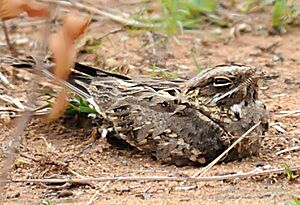Indian nightjar facts for kids
Quick facts for kids Indian nightjar |
|
|---|---|
 |
|
| Conservation status | |
| Scientific classification | |
| Genus: |
Caprimulgus
|
| Species: |
asiaticus
|
The Indian nightjar (Caprimulgus asiaticus) is a small bird. It lives in open lands across South Asia and Southeast Asia. Like most nightjars, it is active around dawn and dusk. You can often hear its special call at these times. This call sounds like a stone skipping on a frozen lake. It is a series of clicks that get faster and faster. Sometimes, you can spot them on roads at night. Their eyes glow red when a vehicle's lights shine on them. It can be hard to tell them apart from other nightjars because their feathers can look very different.
Contents
What is the Indian Nightjar?
The Indian nightjar is a small bird with a short tail. It has white patches on the corners of its tail. Its neck and the back of its head are golden. It has dark cheeks and white spots on the sides of its throat. The top of its head is grey. Its chest has thin brown stripes.
How to Spot an Indian Nightjar
Male nightjars have more white on their tails. Females have more streaks on the top of their heads. You can tell it apart from Sykes's nightjar by its dark undertail. It is different from Jerdon's nightjar because it has a shorter tail and white patches on the sides of its throat.
The call of the Indian nightjar is very unique. People say it sounds like a stone skipping on a frozen lake. Because of this, it was once called the "ice-bird." Some also say it sounds like a ping-pong ball bouncing fast and then stopping.
This bird flies silently after the sun goes down. Its flight is easy and quiet, like a moth. During the day, the Indian nightjar stays very still on the ground. Its feathers help it blend in with the soil. This makes it very hard to see.
Where Do They Live?
The Indian nightjar lives in open woodlands, bushy areas, and farms. They usually sit on the ground or on low trees. You won't find them on high branches.
These birds are found in northwestern India and parts of Pakistan. However, they do not live in the dry desert areas. They are found south of the Himalayas. They live in low areas stretching east to Bangladesh, Myanmar, and Vietnam. They also live in Sri Lanka.
Reproduction and Life Cycle
Indian nightjars do not build a nest. They lay two beautiful creamy pink eggs right on the bare ground. This happens between February and September. The parent bird sits very close to the eggs. Its feathers help it hide well. Sometimes, the eggs might be moved a short distance. When a chick hatches, it is covered in soft down feathers. It is brown on top and light reddish-brown underneath. Their eyes are open when they hatch. Chicks can sit up straight and make a soft sound.
What Do Indian Nightjars Eat?
Nightjars are most active and eat mostly around dawn and dusk. These times are called twilight. At dusk, they often fly near farm animals. They catch insects that swarm around the animals. At night, they like to catch insects that gather around street lamps or other bright lights. They fly with their mouths wide open to catch small insects in the air.
Nightjars might also hunt under tree branches. They fly from their favorite resting spots. They catch insects that are about 5 to 15 feet (1.5 to 5 meters) high. They usually take bigger insects back to their resting spots. When they hold insects in their beaks, they keep their heads up. They shake the prey and swallow it whole. Sometimes, they break the insects into pieces before eating them. They can also pick up insects from the ground or leaves. Young nightjars usually sit on the ground. Then they make short jumps or flights to catch insects.
Most of their food is flying insects. This includes mosquitoes, flies, beetles, locusts, and winged ants. They also eat moths and grasshoppers. Sometimes, they eat plant lice and crickets. They might also eat insect larvae, nymphs, and eggs.
This common bird often rests on roads at night. They sometimes catch insects under street lights. Their eyes reflect light brightly. This makes them easy to see in the beams of car headlights. However, bright lights can confuse them. Many nightjars are sadly killed by cars.
Images for kids



